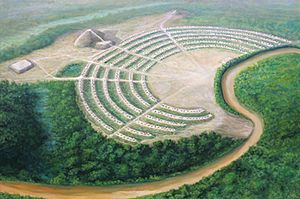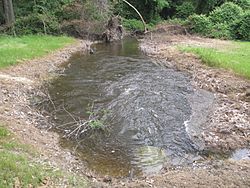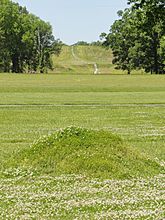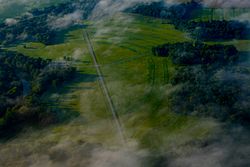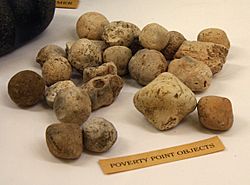Poverty Point culture facts for kids
The Poverty Point culture was a group of ancient Native American people. They lived in the lower Mississippi Valley and along the Gulf Coast of North America. This was a very long time ago, between about 1730 BC and 1350 BC. Scientists have found over 100 places where these people lived. They were known for building large mounds of earth. They also had a big trading network across much of what is now the eastern United States.
Contents
Discovering the Poverty Point Culture
Before the Poverty Point culture, another ancient site called Watson Brake existed in Louisiana. People there built eleven earth mounds around 3500 BC. This makes Watson Brake one of the oldest mound sites in the Americas.
The Poverty Point culture came next, thriving from 1730 BC to 1350 BC. This was during a time called the late Archaic period in North America. More than 100 sites show evidence of this culture. One important site is the Jaketown Site in Mississippi.
The biggest and most famous site is Poverty Point itself. It's located on the Macon Ridge near Epps, Louisiana. The culture is named after this archaeological site. The site got its name from a cotton plantation built there in the 1800s.
The Poverty Point culture might have been strongest around 1500 BC. It was one of the first complex cultures in the Mississippi Delta region. These people lived in villages that stretched for about 100 miles (160 km) along both sides of the Mississippi River.
After the Poverty Point culture, other groups like the Tchefuncte and Lake Cormorant cultures appeared. These later groups traded over shorter distances. They also built smaller public projects. They started using pottery for cooking and storage more often. They did not create as many carved stone objects as the Poverty Point people.
Amazing Earthworks and Structures
The earthworks at Poverty Point are not the oldest in the United States. The ones at Watson Brake were built about 1900 years earlier. However, the Poverty Point earthworks are the oldest of their huge size in the Western Hemisphere.
In the middle of the site is a large open area called a plaza. It covers about 37 acres (15 hectares). Archaeologists believe this plaza was used for public events. These might have included ceremonies, rituals, dances, and games.
The site has six huge, curved earth ridges. They form a half-circle shape, one inside the other. Ditches, or swales, separate these ridges. The dirt for the ridges was dug from these ditches. The ends of the outermost ridge are about 1204 meters (3/4 of a mile) apart. The inner ridge ends are about 594 meters (1,950 ft) apart. If these ridges were straightened out, they would be about 12 kilometers (7.5 miles) long!
Originally, the ridges were about 4 to 6 feet (1.2 to 1.8 meters) high. They were about 140 to 200 feet (43 to 61 meters) apart. Over many years, farming has made some ridges only about 1 foot (0.3 meters) high. Archaeologists think that 500 to 1,000 people lived in homes built on these ridges.
Poverty Point was the largest settlement in North America at that time. The site also has a large earthen pyramid. It is about 50 feet (15 meters) high and 500 feet (150 meters) long. It was built to line up from east to west. There is also a huge bird-shaped mound, called an effigy mound. It is about 70 feet (21 meters) high and 640 feet (200 meters) across.
On the western side of the plaza, archaeologists found some very deep pits. One idea is that these holes once held huge wooden posts. These posts might have been used as a calendar. By watching the sun's shadows, the people could have known when the seasons were changing.
Building these massive earthworks took a lot of hard work. It also required great organization and skill over many centuries. One expert figured that it would take over 1,236,007 cubic feet (35,000 cubic meters) of soil to build the earthworks. This means 1,350 adults would have had to work 70 days a year for three years!
Tools and Art of the Poverty Point People
-
Carved stone objects, including atlatl weights and gorgets.
Archaeologists have dug up many interesting objects at Poverty Point. These include animal figures and hand-shaped, baked-clay cooking objects. They also found simple pottery, stone bowls, and tools like spear points, hoes, and drills.
The people used stone cooking balls to prepare their food. Scholars believe dozens of these balls were heated in a bonfire. Then, they were dropped into pits with food to cook it. Different shapes of balls helped control the cooking temperature and time.
Crude human figures were also found. These are thought to have been used for religious purposes. Points made of gray flint from the Midwest were discovered too. Heavy iron ore from Hot Springs, Arkansas was used to make plummets. These were weights for fishing nets.
Many of the raw materials came from far away. Things like slate, copper, galena, jasper, quartz, and soapstone were brought from up to 620 miles (1,000 km) away. This shows how far the Poverty Point trading network reached.
The Poverty Point culture was known for making high-quality, small, carved, and polished stone beads. Other early cultures in eastern North America usually made beads from softer materials like shell or bone. The beads often showed animals common to the area, such as owls, dogs, locusts, and turkey vultures.
See also
 In Spanish: Cultura de Poverty Point para niños
In Spanish: Cultura de Poverty Point para niños



